Dirk Hoke strides into his corner office at Volocopter’s headquarters with the confidence of someone who knows he is in demand, and time is ticking. Dressed in business casual and wearing bright white trainers, the former Airbus Defence & Space chief executive has wholeheartedly embraced the role of start-up CEO.
An air of impatience extends beyond Hoke’s glass cube. Dozens of employees buzz around the open-plan office, tapping away on laptops at height-adjustable desks, or taking calls in soundproof pods. As if in uniform, many sport dark blue hoodies emblazoned with the company’s stylised triangle logo.
It is easy to forget that Volocopter is based in the small southwestern German town of Bruchsal, far from the nation’s aerospace clusters of Munich and Hamburg. The region is better known for its asparagus crop, and the city’s main tourist attraction is a baroque palace built in 1720.
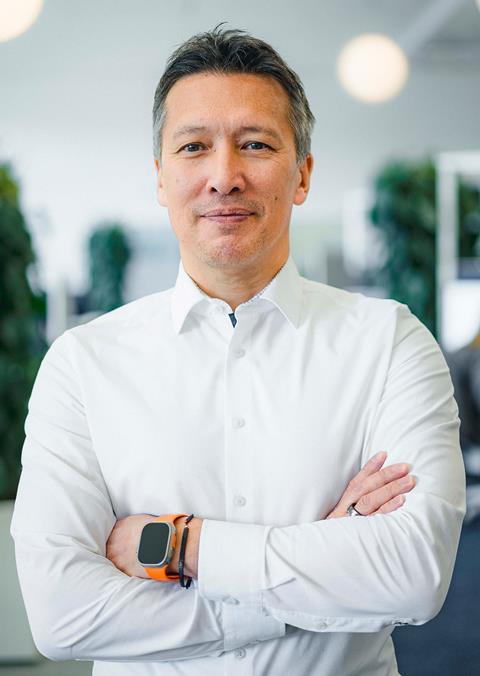
In the office, a stone’s throw from the old freight railway depot, there is a distinct Silicon Valley high-tech vibe. In addition to the ubiquitous hoodies and free lunch in the company cafeteria, wall art in the restrooms reminds employees that they are “Where the magic happens”.
There is a distinct feeling of two very disparate worlds colliding.
“Our marketing people did a really good job in building a strong brand,” Hoke says. “When you walk around in the city or if you go to the restaurants, people are proudly wearing Volocopter hoodies, even outside of work.
“The hoodies are also really good quality,” he adds.
“Really good quality” has also traditionally been a trademark of German engineering. Within just two generations in the second half of the 20th century, Germany went from vanquished military power to Europe’s economic powerhouse – fueled primarily by the nation’s automotive, mechanical engineering, chemical and electrical industries.
German engineers also channelled their creativity and ingenuity into aviation, and Volocopter is building on that legacy.
The company was founded by two students in 2011 when they sent a rickety contraption – VC1 – into the air, to prove that they could. A “test pilot”, wearing just a motorcycle helmet for protection, sat atop a yoga ball to which 16 electric motors were strapped. The flight lasted 90s.
Now, seasoned managers with major aerospace company experience lead 650 employees hailing from 60 countries. As of the end of April, Volocopter’s prototypes had conducted more than 2,000 test flights with five post-yoga-ball aircraft, including demonstrations in nine other countries.
Having raised more than €500 million ($538 million) in start-up funding, Volocopter has emerged as a global leader in the race to certify a whole new class of air transport vehicles. Hoke promises an electric vertical take-off and landing (eVTOL) revolution.
“It’s not rocket science,” he says. “I’ve done rocket science. It’s just sweat and blood and hard work every day. All the technology elements are there.”
At last summer’s Paris air show, Hoke surprised the industry by boldly proclaiming the German air taxi company would launch commercial operations of its fourth-generation multi-rotor vehicle, VoloCity, at the city’s Olympic Games – scheduled to begin just one year and 36 days later.
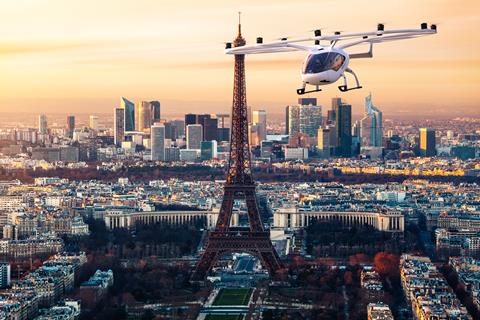
Speaking to FlightGlobal just weeks before the event and battle-hardened by seemingly never-ending negotiation with French security authorities and the European Union Aviation Safety Agency (EASA), coupled with the industry’s notorious ongoing supply chain woes, he reluctantly walks back from that aspiration.
“I cannot guarantee what we will do in Paris,” he says. “It’s complex, and still a work in progress, and can change even at the last second.
“What the final decisions are, on authorisation, on safety, security, on our progress on towards certification, what kind of permit we will fly under, and which vertiports will we be allowed to use… we are working on keeping all options open.”
OLYMPIC OPTIONS
VoloCity’s options range from, at best, selling tickets for an air taxi ride to anyone (for €10-15 per person per kilometre), all the way through limited operations with a permit to fly – either transporting athletes or other third-party guests, or at its most restrictive, a basic demonstration flight campaign with just one test pilot on board.
A network of five vertiports across the French capital will be completed before the event, and routes have been defined.
“Everyone is committed, from the highest level of the French government through the different ministries and local authorities, municipalities, us, EASA – everyone involved wants to make it happen.
“So there are different steps, depending on the level of achievement and the confidence that all parties have into flying into congested airspace and a very complicated safety situation.”
But just getting this far is already an achievement, and even if the Olympics prove to have been too ambitious a target, Parisians will still be able to get a close look at what urban air mobility can do.
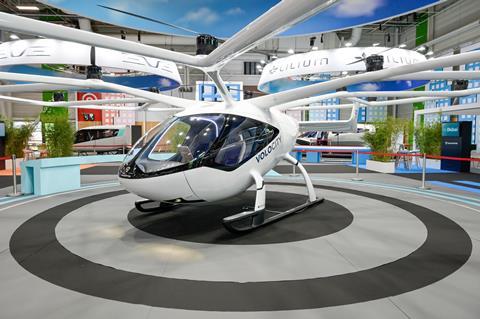
“We want to prove that if the population of Paris will accept it, then we can fly anywhere in the world,” Hoke says.
The company plans to spend the next two years working to gain the public’s trust, now that the technology is maturing and certification appears to be within reach.
“The problem that we have is with people who have not witnessed the vehicle flying. When they see it [on the ground] they see it looks a bit like a helicopter, so the perception is: loud, not totally safe and expensive.
“Once you have seen and heard it operate, people change their opinion, and that’s why this opening phase is so important for scaling up.”
After all, this is a billion-euro business, and its backers hope for a return on investment some day.
“You have people that think this is totally crazy, and we don’t need this product at all. And you have people that think this is the best thing ever.”
It is now time to bring those in the former camp into the latter.
CERTIFICATION QUESTIONS
According to the company, the VoloCity is still on track to be certificated by European regulators later this year, with US certification six months later. But EASA and the Federal Aviation Administration (FAA) disagree on safety rules in the unlikely event of a catastrophic failure.
EASA maintains eVTOL aircraft must prove safety probability of ten to the minus-nine (10⁻⁹) or one catastrophic failure in one billion flight hours. In North America, regulators appear to have taken a less rigid approach, with certification standards looking to be set at 10⁻⁸, one in 100 million, or 10⁻⁷, one in 10 million flight hours.
“EASA will not move from 10⁻⁹ as a prerequisite to fly in civil airspace, no way,” Hoke says. So by certificating in Europe first, the VoloCity has that buffer when it seeks the FAA’s blessing.
In addition, the regulators have taken different approaches to the details of testing, for example of batteries or other systems, or cascading errors that could lead to a catastrophic failure.
Inevitably, though, the sector will have a very public failure that could mean the end of companies like Volocopter and urban air mobility.

“Anything that happens, anywhere, will have an impact on everyone,” Hoke says. “That’s why we hope that the FAA and EASA get to an agreement on the safety level. Because there’s a big difference between 10⁻⁷ and 10⁻⁹. If something happens with a vehicle that’s certified against 10⁻⁷, no-one in the public will see the difference. They will just blame us.”
Hoke takes a practical view when it comes to dealing with the aviation regulators, and says that while getting a product from the drawing board to the commercial market is not easy or cheap, there are ways to smooth the rough edges for both parties.
“Is it worth it to fight with a regulator for two or three years to certify a certain component, or should we take an approach that they know, and they feel more comfortable with,” he asks. “Afterwards, when we have proven that component is safe, we can take the next step to make it simpler.
“For the regulators it’s the first time and for us it’s the first time, and both sides want to guarantee when someone gets into the aircraft, that it is safe, and we will not compromise on that.”
FINANCIAL CONTROL
Like others in the eVTOL space, Volocopter is burning cash as it races to certification. Hoke will not detail the company’s current financial status, but he does say that its annual spend is “much, much lower” than at other companies.
The chief executive of a northern California-based eVTOL competitor once said that the certification journey for one of these new aircraft types will cost around $1 billion.
“We will be definitely below that, and we are demonstrating that can be done,” Hoke says. “We could have done better, but even if we would include development of the next vehicle, we would still be far below what is spent on the other side of the ocean.”
How is that possible?
“I think Silicon Valley is not the cheapest place to build an eVTOL,” he says.
The “next vehicle” he alludes to is the VoloRegion, a pilot-plus-four-seat fixed-wing design that will connect cities with suburbs and which the company aims to bring to market by 2027. The more seats in the aircraft, the better the economics will work.
With three paying passengers, Hoke says the cost could come down to about €3-5 per person, per kilometre. The larger craft’s payload will be between 420-430kg (926-948lb) – enough to transport either three adults, or a family of four with minimal luggage.
Between 2035 and 2040, Volocopter also sees scope to pluck the pilot from the aircraft, and add another revenue passenger.
“Autonomy will increase the business case tremendously,” he says. “But before that happens, we need to be certified for instrument flight, and that means we need to be integrated into air traffic control.”
Industry experts, and Hoke himself, know not to hold their breath on that one.
“I always say once we see Airbus and Boeing commercial aircraft fly with a single pilot, then we will be getting closer to flying with autopilot,” he adds.
For the moment, though, the firm’s full energy is going into certification of the VoloCity, with the VoloRegion remaining just a concept, as the company searches for a manufacturer to help sponsor its development.
So far, a few notable names have jumped on the VoloCity bandwagon. The aircraft has attracted the attention of Germany’s non-profit helicopter rescue organisation ADAC Luftrettung, which has placed two firm orders with options for 150 more, and Bristow Group, which has also committed to two orders and 78 options.
Volocopter is also looking to operate its VoloCity at the World Expo 2025 in Osaka, and Japan Airlines has indicated it could take up to 100 aircraft. In 2021 the airframer signed an agreement to launch a joint venture with Aerofugia, a subsidiary of China’s Geely Technology Group, which has expressed interest in up to 150 aircraft.
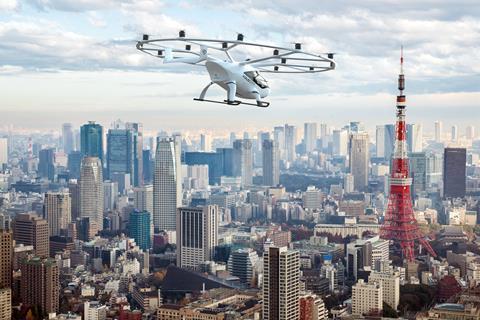
Saudi Arabia’s NEOM economic zone also has signed on for 15 examples, and Volocopter flew its prototype in that region last year.
Hoke has a secret wish list of 40 locations with which the company could partner. But it has set up some guardrails to ensure the overall long-term success of the eVTOL proposition.
“We cannot do everything. So we will focus on the [cities] that are really dedicated, and they understand it’s not a [profitable] business model in the first two years, but it will be afterwards.”
A short drive away from headquarters (in one of the company’s conspicuously branded electric cars), is Volocopter’s production facility, large enough to accommodate a rate of 50 aircraft per year, per shift.
The first parts for certification-conforming VoloCity airframes made here wait to go through quality control and final assembly. That last step takes place at a third location – a hangar adjacent to Bruchsal airfield’s grass runway, with a vertiport for flight testing.

The company received an extension of the German Federal Aviation Authority’s (LBA’s) Production Organization Approval (POA) for the new buildings earlier this year. That allows the start-up to manufacture all of its own composite carbonfibre parts, as well as all aspects of the electric propulsion system in-house, and to begin serial production.
UNIVERSAL APPROVAL
Volocopter is the world’s only eVTOL company so far to hold both design organisation approval (DOA), which it received in 2019, and POA, first granted in 2021. In March it added LBA certification as an approved training organisation (ATO) for pilots.
During our visit, parts for two aircraft were in production, including the company’s first own-constructed fuselage shell. At the hangar, three airframes in various stages of assembly occupied the shop floor – a space designed for five. Engineers conduct flight tests almost daily unless the fickle northern European weather refuses to play along.
Despite a tight labour market, late-stage start-up Volocopter has been successful in finding the specialists it needs to thrive, even as other German industrial companies struggle to find talent.
“We get more than 50,000 job applications every year,” says Hoke, who notes that the ‘coolness factor’ “makes it easier”.
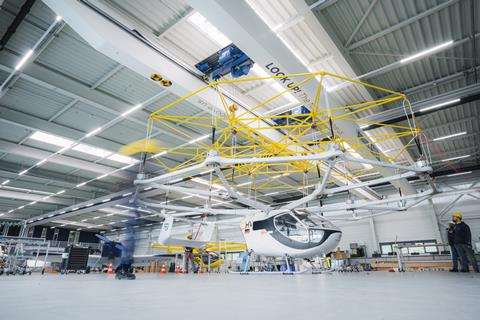
But amid the enthusiasm of the eVTOL dreamers, there are cautionary voices and many questions to which the nascent industry does not yet have answers.
Current battery technology is unable to match the range of a traditional, fossil-fueled small helicopter (and will not do so for a long time), strict weight restrictions limit the craft’s payload, landing spots will be rare, and authorities are still holding back on opening the regulatory floodgates. And at some point, the money will run out.
“Success and non-success are very, very close together,” Hoke says. “There will be consolidation, for all of us, and we have to live with this prospect every day.”
And fundraising is a constant discussion.
In late April, the company was confronted with that reality when an expected state loan guarantee of up to €100 million did not materialise, leaving it to scramble for alternative means of financing. Even declaring insolvency is not off the table, it cautions.
“Volocopter has been transparent that the fundraising market has been difficult in the past few years. The German federal government is still very supportive of Volocopter… but in general, Germany has very limited mechanisms to support start-ups in the late stages of financing,” he says.
Hoke is not one for frenzied exuberance, nor does he succumb to despair when a component, a process, or a flight test fail to meet the standards he and his teams have set. Innovation is hard, reaching milestones is harder, and changing mindsets is harder yet. It is one thing to imagine something cool, and quite another to make it real.
But even if progress is slow, Hoke is convinced that by the 2030s, the technology will have found its niche, and its commercial value.
“Because it will be in small steps, people will not realise it’s a revolution,” he says. “Twenty years from now will we be able to call it a revolution.”


























